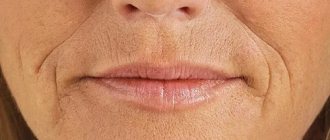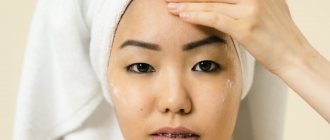Dermatovenereologist (cosmetologist)
Baichorova
Marua Azretovna
21 years of experience
Dermatologist (cosmetologist)
Make an appointment
The constant process of skin renewal can cause blockage of the sebaceous glands and follicles. Getting into microscopic holes, excess sebum and dead cells of the exfoliated epidermis lead to the appearance of blackheads or pimples. Experts have united them under the name “comedones”. The situation is aggravated by the lack of proper skin care, exposure to unfavorable sanitary conditions, as well as the intense production of sebum, the excess of which clogs the ducts and hair follicles.
The vast majority of cases of comedones are observed on oily facial skin: on the nose, forehead and cheeks. According to most medical specialists, such a pathology is true evidence of hormonal imbalances, hidden dermatological problems and malfunctions of the liver and gastrointestinal tract. Therefore, patients who experience discomfort from their appearance are advised not to focus on the cosmetic problem, but to undergo a comprehensive examination to identify possible diseases of the internal organs.
Etiology of the disease
The opinion that comedones appear only in adolescents and young adults is not entirely true. They occur in up to 85% of patients under 25 years of age, after which sebum production decreases and the conditions for blockage of the glands disappear on their own. Also, women often suffer from the disease during pregnancy and at the onset of menopause, when the body experiences a significant hormonal load. The intensive development of the disease can be caused by unsanitary working or living conditions, lack of proper skin care, neglect of hygiene rules and other reasons due to which the adverse effects on the skin of the face acquire such unpleasant consequences. Refusal to treat comedones can cause the formation of scars and age spots at the site of the rash, which can only be eliminated using plastic surgery methods.
Cosmetology procedures for removing comedones in the salon
A corrective home routine can be supplemented with salon beauty treatments on a regular basis or courses. Procedures and salon care are selected individually by a cosmetologist based on the type, condition and needs of your skin. Aesthetic procedures do not replace the basic steps of regular home care: daily cleansing, toning, moisturizing and mattifying will help oily, problem skin stay clear and look healthy for a long time.
List of salon treatments for comedones:
- Cleaning (mechanical, ultrasonic, hardware);
- Peels of various types and depths of exposure (superficial, medium, deep);
- Phototherapy – the procedure reduces acne, smoothes post-acne (pigmentation and scars);
- Biodermabrasion or Microdermabrasion (resurfacing) - procedures fight hyperkeratosis and enlarged pores, improve microcirculation, help skin cells regenerate faster, reduce post-acne, and are suitable for treating non-inflammatory forms of rashes.
Reasons for the formation of comedones
A black dot or raised white spot on the surface of the skin is excess sebum that is stuck in the sebaceous duct or inside the follicle. The resulting plug disrupts the functioning of the glands and forms a closed environment, ideal for the proliferation of pathogenic microorganisms. Their vital activity “enriches” the plug with toxins, which causes a local inflammatory process and its subsequent spread to healthy areas of the skin.
Among the reasons causing the appearance of multiple comedones on the face, ears or back, experts call:
- hyperactivity of the sebaceous glands;
- use of low-grade cosmetics;
- lack of proper facial care, as a result of which excess sebum and epidermal cells remain on the skin;
- refusal to remove traces of cosmetics before bedtime;
- smoking;
- living or working in an environment characterized by the presence of dust and small particles of dirt in the air;
- unbalanced diet, dominated by fatty, smoked and spicy foods, sweets and flour products;
- deficiency of microelements and vitamins.
A comprehensive examination of the body of a patient complaining of open and closed comedones often reveals hidden pathologies of the following nature:
- liver and gastrointestinal diseases;
- hypothyroidism, gonadal dysfunction, other hormonal disorders;
- genetic predisposition of the skin to inflammation;
- intensity of production of certain hormones, their imbalance in the body;
- uncontrolled use of hormonal drugs;
- frequent stress, sleep disturbances, insomnia.
Complete removal of an external skin defect is only possible if the internal causes listed above are eliminated.
Why do you need to get rid of them?
The usual closed comedones are white. Some people ignore single comedones, but in vain! The risk of inflammation is high: redness appears, then a painful papule, turning into a pustule filled with pus. In fact, this is the beginning of the development of a skin disease - acne.
According to the international classification of acne, the formation of comedones is the zero or initial stage of acne development . Treatment for comedones is necessary to prevent the development of more severe forms of acne.
Varieties and features
The skin is sensitive to lack of care and disruptions in the body. Among the symptoms that precede the appearance of subcutaneous comedones, most patients note:
- a sharp increase in skin oiliness;
- density and roughness of the skin;
- change in natural skin color to an unattractive pale gray-green shade;
- dense nodules, indicating blockage of the sebaceous glands and hair follicles.
There are open and closed comedones, which differ in appearance. Black spots on the surface of the cheeks, nose and chin, the so-called T-zone, are an open form of the disease. Noticeable white sebaceous plugs under the skin are a closed type of pathology. They often develop against the background of hidden inflammatory processes due to skin damage by a fungal infection, staphylococcus or pathogenic bacteria. Lack of proper treatment causes plugs of purulent acne to appear at the site, which leave behind scars and scars.
The localization area for closed white comedones on the face is the forehead, nose and chin, as well as the décolleté and upper back. The appearance of formations on the body is often associated with wearing synthetic underwear and clothing, which does not allow air to pass through and causes the skin to secrete sweat. Trying to fight comedones by squeezing in unsanitary conditions only aggravates the problem. The pustular infection spreads to nearby healthy areas of the skin, and the disease progresses rapidly. And in place of the squeezed out formations there remains a serous crust and an inconspicuous scar, indicating damage to the skin.
Open comedones, or blackheads, acquire an unpleasant appearance due to contamination of the sebaceous plug with dust or residues of cosmetics. When exposed to air, the contents of the sebaceous duct oxidize and darken, making it visible on the surface of the skin. Removing such comedones does not bring the expected effect. The empty gland duct soon becomes clogged with fat, and the disease again makes itself felt with an unpleasant cosmetic effect.
Factors contributing to acne
There are reasonable claims that the phenomenon of comedones appears on the face due to the abuse of cosmetics, hormonal disorders, poor ecology, long-term use of antibiotics or hormones, and stress. Also, a photo with signs of the disease is expected with a genetic predisposition.
When to see a doctor
Experts recommend not delaying a visit to the doctor if symptoms of inflammation and blockage of the sebaceous glands appear. You should not put up with an unpleasant cosmetic effect or try to cope with it using home methods, at the risk of intensifying the pathological process. Moreover, modern medicine has at its disposal many effective methods of combating the disease, depending on the type and general condition of the skin.
Are you experiencing symptoms of comedones?
Only a doctor can accurately diagnose the disease. Don't delay your consultation - call
Whiteheads (closed comedones)
This form of the disease is represented by small white rashes with a diameter of 0.1-3 mm, which can be palpated. The outlet of the pilosebaceous follicle, despite the fact that it is completely filled with a compact substance, is visible to the naked eye. Closed comedones are prone to transformation into inflammatory elements, but some of them resolve on their own within 3-4 days. 32
One of the modern means for treating acne is Azelik® gel. It is suitable for external treatment of acne of I and II severity (including in the presence of papulopustular acne).5
Such acne on the face and body is found 4 times more often than open comedonal acne.32
Diagnostics
For an experienced dermatologist, an external examination of the patient’s skin is enough to immediately make the correct diagnosis. Specialized laboratory research methods allow us to clarify the mechanism of development of the disease and the presence of pathologies of internal organs: blood tests for hormonal balance and internal infections, tomography of the gastrointestinal tract and liver. It is possible to prescribe additional measures as part of a standard examination if the patient has a history of serious diseases of the internal organs.
Risk factors
In addition to the main reasons, there are a number of factors that increase the risk of developing comedones. The most significant include:
- Hereditary predisposition.
- Frequent stress and emotional overstrain, lack of sleep.
- Natural fluctuations in hormonal levels, including during puberty and the transition to menopause.
- Endocrine diseases: hyperthyroidism, diabetes mellitus type 1 and 2, polycystic ovary syndrome, hyperandrogenism.
- Poor nutrition: excessive consumption of flour and confectionery products, whole milk products, fatty and fried foods.
- Smoking and excessive consumption of alcoholic beverages.
- Pathologies of the gastrointestinal tract: gastritis, peptic ulcer of the stomach and duodenum, dysbacteriosis.
- Friction or pressure on the skin, such as the use of mobile phones, helmets, tight collars and backpacks.
Pregnancy and the onset of menopause
One of the important triggering factors for comedones is hormonal imbalance.
Quite often this is due to a change in the ratio between male and female sex hormones (androgens and estrogens). Natural hormonal changes in the body, for example, occur during pregnancy and at the beginning of menopause. The sebaceous glands are also part of the endocrine system and are controlled by androgen receptors. Steroid sex hormones (dihydrotestosterone) are responsible for the synthesis of sebum. As a result of sharp fluctuations in the ratio of androgens and estrogens, the synthesis of sebum is stimulated, and the division of cells in the stratum corneum of the skin increases, which often leads to the formation of comedones.
Treatment
You can cope with the appearance of a limited number of pimples and comedones of any type with the help of careful skin care. In case of intense shedding, consultation with a dermatologist is required. He will select a remedy for comedones and a suitable list of procedures to free the ducts (so-called extraction) and reduce the volume of sebum production.
In most cases, the following treatment methods are used:
- mechanical cleansing of the face - carried out after thorough cleaning and warming of the skin using the fingers, a Uno spoon or a Vidal needle. After cleaning, the skin is treated with alcohol. Provided the contents of the duct are completely removed, the risk of infection is reduced to zero, and there are no signs of hyperemia or inflammation on the face. During the day, it is strictly forbidden to use cosmetics so that its particles do not clog the open duct;
- enzymatic peeling using exotic fruit extracts. Loosening the stratum corneum of the skin allows comedones to come out naturally or through brosage - a cleaning procedure with soft brushes. Peeling is contraindicated in the presence of ulcers, exposure to which can cause skin infection;
- disincrustation is a hardware technique for removing comedones under the influence of a weak electric current. This method is used relatively rarely due to multiple contraindications;
- peelings - chemical, acidic, film or sheet, the effect of which softens the skin and frees the ducts from impurities. At the same time, the substances contained in the peeling preparation relieve the inflammatory process and soothe the skin;
- ultrasonic facial cleansing – treatment using ultrasonic waves, the “impact” of which gently “knocks out” plugs. At the same time, the procedure has a pronounced cosmetic effect - it removes wrinkles, refreshes the complexion, tightens the skin;
- Vacuum skin cleansing – gentle removal of plugs from the ducts, leaving no noticeable marks. The procedure is contraindicated for patients with rosacea, because there is a risk of injury to small vessels.
Please note: squeezing comedones and using dubious home remedies can worsen your skin condition. It is also not recommended to select medications at the pharmacy on your own, relying on commercials and advice from friends. Treatment should be prescribed only by an experienced specialist who has studied the results of diagnostic studies.
How to get rid of comedones?
In case of comedonal acne, facial cleansing can be performed. The most primitive is the mechanical one, when a specialist removes comedones with his hands or an instrument. But this is a traumatic procedure, which is better replaced by an ultrasound, atraumatic technique. Peels can also be carried out with fruit acids; they act as a means to “dissolve” comedones. But only a specialist should carry out the procedures in a clinical setting.
Acne can be treated at home. For mild to moderate acne, Azelik® gel, which contains azelaic acid, can be used for this purpose.5
An effective remedy against acne is considered to be one that affects several parts of its pathogenesis. The main ones include: inflammation, follicular hyperkeratosis, increased colonization of propionibacteria, increased sebum production. For mild acne, as a rule, the use of topical medications is sufficient; for moderate and severe acne, systemic medications are added to them.
How to make an appointment with a dermatologist at JSC “Medicine” (clinic of academician Roitberg) in Moscow
You can make an appointment with the specialists of JSC "Medicine" (clinic of Academician Roitberg) on the website - the interactive form allows you to select a doctor by specialization or search for an employee of any department by name and surname. Each doctor’s schedule contains information about visiting days and hours available for patient visits.
Clinic administrators are ready to accept requests for an appointment or call a doctor at home by calling +7 (495) 775-73-60.
Convenient location on the territory of the central administrative district of Moscow (CAO) - 2nd Tverskoy-Yamskaya lane, building 10 - allows you to quickly reach the clinic from the Mayakovskaya, Novoslobodskaya, Tverskaya, Chekhovskaya and Belorusskaya metro stations .











